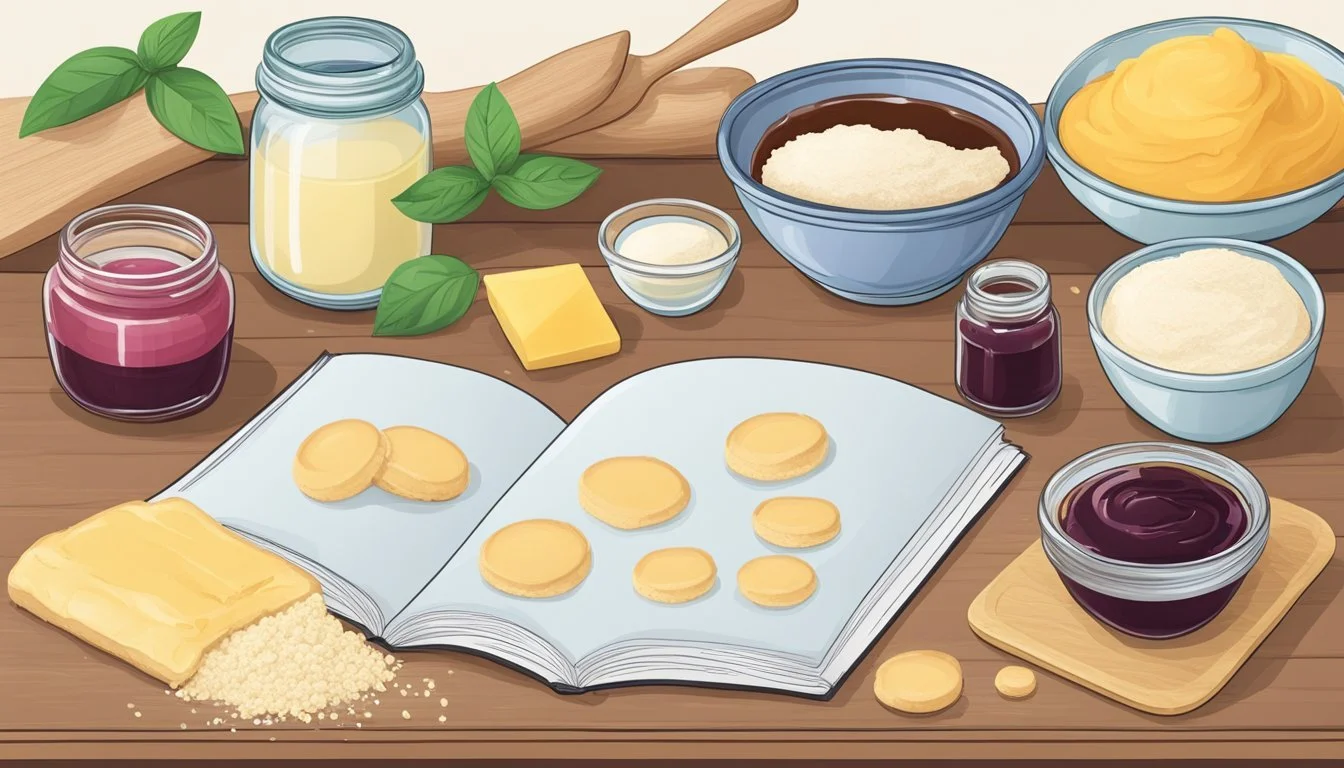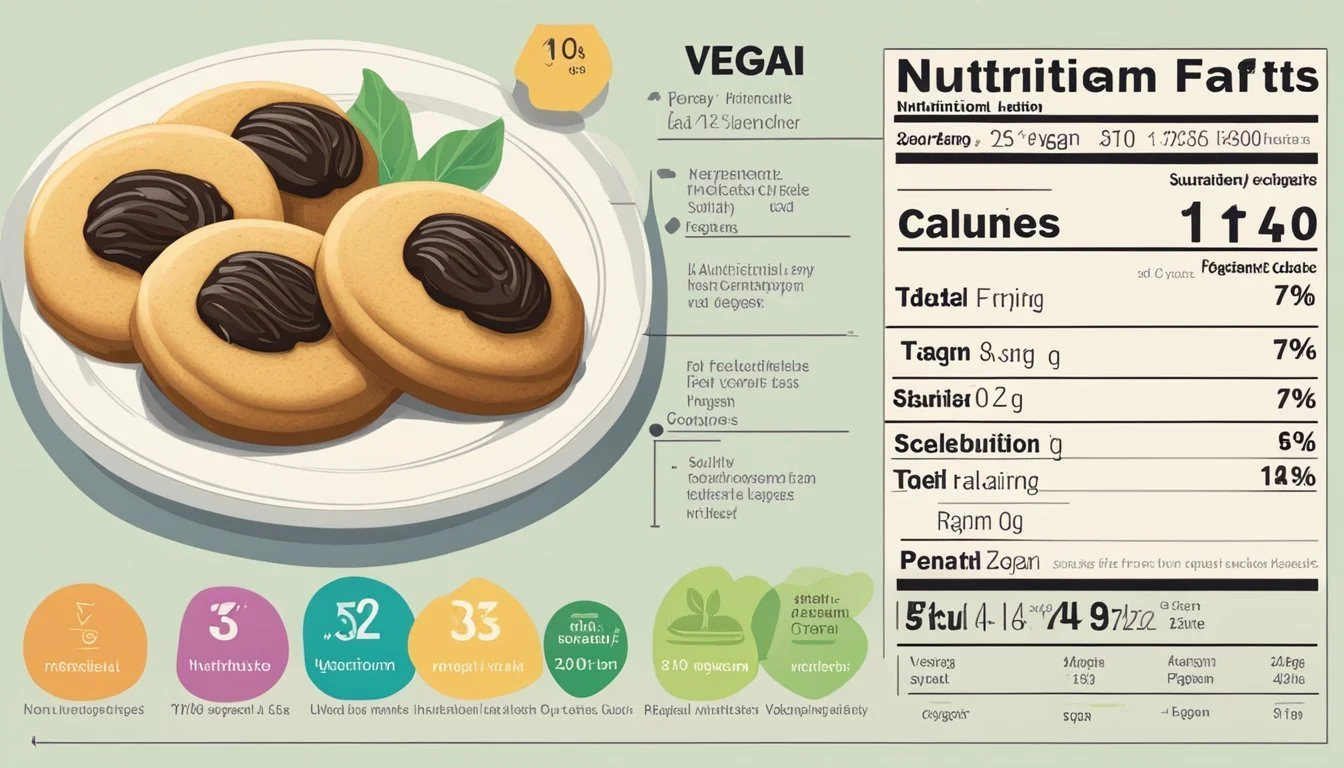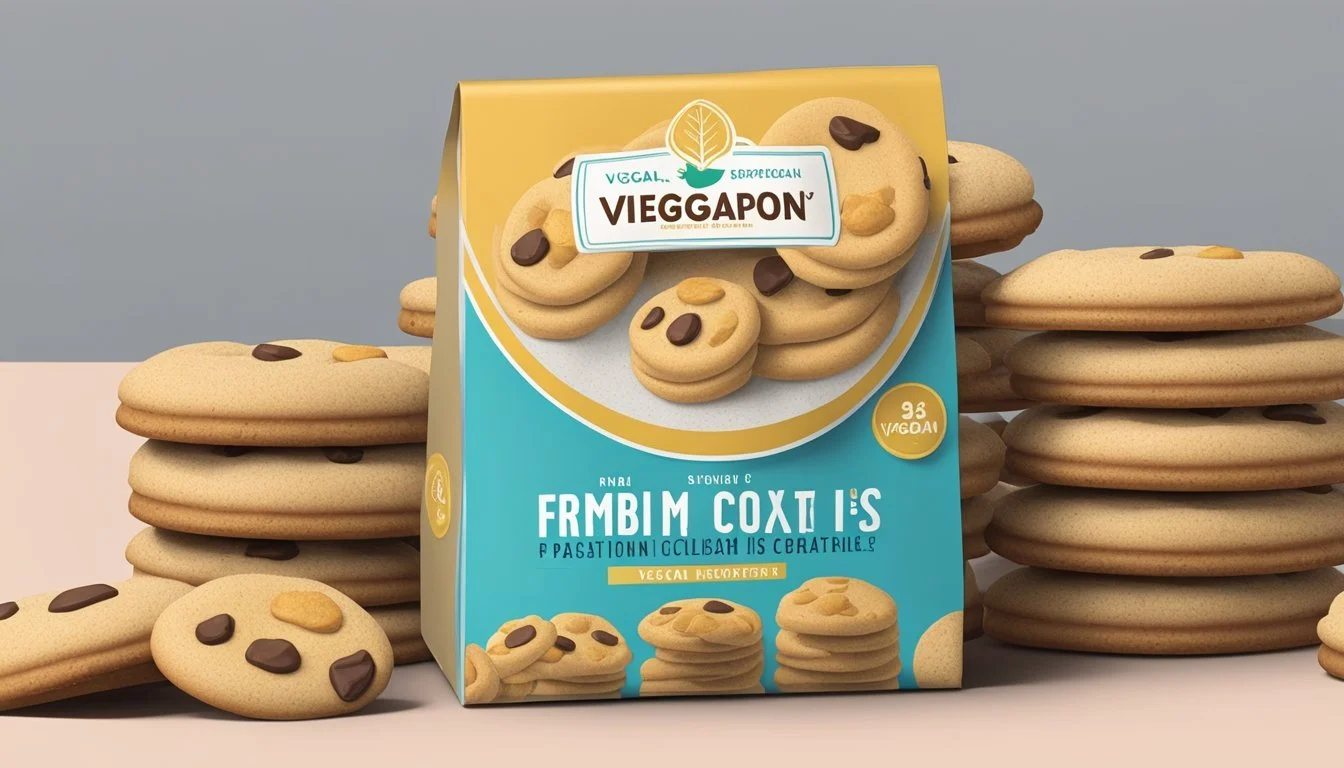Are Thumbprint Cookies Vegan?
Unveiling the Ingredients
Thumbprint cookies, known for their distinct indentation filled with jam or chocolate, are a classic treat enjoyed by many. Traditionally, thumbprint cookies are made with ingredients that include butter, eggs, flour, and sugar, which are not consistent with vegan dietary choices. Vegans avoid all animal products for ethical, environmental, or health reasons, which means traditional thumbprint cookie recipes require modification to fit a vegan diet.
Recently, vegan thumbprint cookies have emerged as a popular alternative, allowing those following a plant-based diet to enjoy this sweet indulgence. These vegan versions are crafted using substitutes for the non-vegan ingredients commonly found in traditional recipes. For instance, plant-based butters and non-dairy milks are used in place of their animal-derived counterparts, and binding agents such as applesauce or flaxseeds can take the place of eggs. The result is a cookie that aligns with vegan principles without compromising on the comforting flavors and textures that make thumbprint cookies a beloved treat.
The availability and variety of vegan thumbprint cookies have increased as more consumers seek plant-based options. These cookies can be made at home with a range of recipes available online, or purchased from bakeries that cater to vegan diets, with flavors ranging from classic raspberry jam to chocolate and even exotic fruit fillings. The cookies retain their 'melt-in-your-mouth' quality and are as aesthetically pleasing as their non-vegan counterparts, making them a delightful option for anyone looking to enjoy a cookie that's both vegan and delicious.
Vegan Cookie Basics
When it comes to vegan baking, one must understand the core principles and the substitution ingredients that maintain both the vegan ethics and the desired texture and flavor of the baked goods.
Defining Vegan Baking
Vegan baking excludes all animal products, meaning no eggs, dairy, or honey. For cookies like the humble thumbprint, this practice requires careful selection of vegan-friendly components that mimic the properties of traditional ingredients. Vegan bakers typically replace the binding and leavening properties that eggs provide with plant-based alternatives, and use fats that do not derive from animals nor contribute to dairy industry practices.
Common Vegan Substitutes
Vegan substitutions are crucial in creating a cookie dough that is not only ethical but also delicious. A table of common substitutes used in vegan thumbprint cookies demonstrates how traditional ingredients can be replaced effectively:
Traditional Ingredient Vegan Substitute Butter Vegan butter (made from plant oils) Sugar Vegan sugar (not processed with bone char) Flour All-purpose or gluten-free flour (for those avoiding gluten) Eggs Flaxseed meal, applesauce, or commercial egg replacers
The use of vegan butter and vegan sugar is straightforward—they are direct replacements for their non-vegan counterparts and perform similarly in the creaming process, essential for the light and fluffy texture of cookie dough. Flour, whether all-purpose or a gluten-free blend, provides the structure, and when selecting a flour, one must consider the desired texture of the finished cookie; all-purpose flour yields a classic chewy texture, while gluten-free options cater to dietary restrictions without compromising taste.
Ingredients Breakdown
In vegan thumbprint cookies, the selection of ingredients is crucial for obtaining the desired texture and flavor. Here's an overview of the common components and their roles in the recipe.
Flour Varieties
The base of thumbprint cookies is typically all-purpose flour. It provides structure and is readily available. Some recipes may call for gluten-free flour blends to cater to dietary restrictions. It's important to note that gluten-free blends can alter the texture, often resulting in a more delicate crumb.
Sweeteners and Sugar Alternatives
Granulated sugar is common in thumbprint cookie recipes, imparting sweetness and contributing to the cookie's texture. Alternatives like coconut sugar or agave syrup can be used for different flavor profiles or to adjust the glycemic index.
Vegan Fats and Oils
Traditional thumbprint cookies often use butter, but vegan butter made from plant oils is the alternative here, maintaining the cookie's richness without using animal products. It's essential to cream the vegan butter with sugar to achieve the right consistency.
Plant-Based Milk and Its Uses
Recipes may call for non-dairy milk such as almond or soy milk to adjust the dough's moisture. The choice of plant-based milk can slightly influence the flavor, but its primary role is to help bind the ingredients together.
Natural Flavorings and Extracts
Flavorings like vanilla extract and almond extract are key for adding depth to the cookie's taste. A pinch of salt enhances these flavors and balances the overall sweetness. They are mixed into the dough sparingly but are potent in their contribution to the final taste profile.
Thumbprint Cookie Methodology
This section details the process of making vegan thumbprint cookies. The methodology includes preparing the dough with vegan ingredients, shaping it into balls, creating the signature indentation, and choosing fillings appropriate for a vegan diet.
Mixing and Preparing the Dough
To begin, the cook combines dry ingredients in a large bowl—typically flour and powdered sugar. They then add softened vegan butter and liquid ingredients, such as plant-based milk and extracts, mixing with an electric mixer until the dough is properly combined. The use of parchment paper is recommended to streamline transferring the dough balls onto the baking sheet later.
Shaping the Cookies
Once the dough is ready, it's scooped out into tablespoon-sized amounts. These portions are then rolled into balls between the cook's hands. It's crucial to achieve a uniform size for even baking.
Creating the Thumbprint Indentation
The shaped balls of cookie dough are placed on a baking sheet, spaced sufficiently apart. They press their thumb into the center of each ball to create a deep indentation. This step should be done gently yet firmly to ensure an adequate well for the jam without cracking the dough.
Filling Options for Thumbprints
For the filling, they typically use vegan-friendly jam or preserves, filling each thumbprint indentation carefully to prevent overflow during baking. Cooks have to ensure that the filling doesn't contain any gelatin or other non-vegan elements. Alternative fillings such as a chocolate ganache or a dollop of peanut butter can also be used. After filling, the cookies are baked in a preheated oven, often at 350°F, until the edges are slightly browned.
Thumbprint Cookie Variations
Thumbprint cookies are versatile, allowing for a variety of fillings and flavors. Whether one opts for classic fruit jams or more unconventional fillings, these cookies can easily be adapted to suit different tastes and occasions.
Classic Raspberry Thumbprint
The classic raspberry thumbprint cookie is a staple in many cookie assortments. They typically feature a soft sugar cookie base, indented to hold a dollop of raspberry jam. The jam not only adds a burst of flavor but also contributes to the moist texture, making these cookies especially delicious.
Apricot-Preserves Thumbprint
For a twist on tradition, thumbprint cookies can be filled with apricot preserves. Combining the sweet-tart flavor of apricot with a buttery cookie base creates a balanced and flavorful treat. These variations are particularly popular during the holiday season but can be enjoyed year-round.
Chocolate-Chip Thumbprint Variation
A departure from the fruit-filled versions, chocolate-chip thumbprint cookies incorporate chocolate chips into the cookie dough, offering a double delight of chocolate and a filled center. After baking, the center is often filled with a chocolate ganache or a single chocolate chip, making a decadent twist on the classic thumbprint.
Exotic Jam Choices for Thumbprints
Adventurous bakers might explore a range of exotic jam choices for filling thumbprint cookies. Instead of raspberry, why not fill them with strawberry, blueberry, or mixed berry jams? Each alternative jam brings its own unique taste, transforming the classic sugar cookie into a new experience with every bite.
Vegan Baking Techniques
In vegan baking, the precision of techniques and the use of specific tools contribute significantly to the outcome of the baked goods. This section focuses on optimizing the baking process for vegan thumbprint cookies.
Tools and Equipment
The success of vegan thumbprint cookies starts with the right tools and equipment. A stand mixer or hand mixer can be employed to cream together vegan butter and sugar until the mixture is light and fluffy. Precise measurements are crucial, which makes a set of measuring cups essential. Additionally, lining the baking sheet with parchment paper prevents sticking and ensures even baking, while a cooling rack is necessary for properly cooling the cookies post-baking. For filling the thumbprints, a simple piping bag or spoon will suffice. If the dough is too soft, a freezer can be used briefly to firm it up.
Baking Times and Temperatures
Baking times and temperatures are paramount in vegan cookie baking. Preheat the oven to a consistent temperature, typically around 350°F (180°C), before placing the cookies inside. This ensures a controlled environment where the cookies will bake evenly. Factors such as oven calibration and the color of the baking sheet can affect cooking time, so adjustments may be required.
Testing for Doneness
Vegan cookies might not brown as deeply as their non-vegan counterparts due to the absence of eggs and dairy. To test for doneness, one should look for a slight firmness at the edges and a soft center, as they will continue to firm up while cooling. The thumbprint edges should be a light golden color, indicating it is ready to come out of the oven.
Cooling and Storing Cookies
After baking, thumbprint cookies should be transferred to a cooling rack to allow for even air circulation, which prevents sogginess. Once cooled, vegan cookies are ideally stored in an airtight container to maintain freshness. The layers of cookies can be separated with parchment paper to prevent them from sticking together. Storing in a cool, dry place is paramount, and some may prefer to use a refrigerator to extend shelf life further.
Nutritional Information
When assessing the nutritional profile of vegan thumbprint cookies, one should consider their calorie density, macronutrient balance, and micro-nutrient composition.
Caloric Content Analysis
The caloric content of vegan thumbprint cookies can vary depending on the ingredients used. On average, a single cookie may contain approximately 100 to 150 calories. The caloric value is mainly influenced by the density of the vegan butter, sugar, and flour.
Assessing Macronutrients
Macronutrients in vegan thumbprint cookies generally consist of:
Carbohydrates: These cookies are primarily high in carbohydrates due to ingredients like flour and sugar contributing to the bulk of their carb content, including a variable amount of dietary fiber depending on the flour used.
Protein: Protein levels may be lower compared to other nutrients; however, the use of almond flour or other nut-based ingredients can slightly increase the protein content.
Fats: Vegan thumbprint cookies contain fat from vegan butter or nut butters, with a focus on minimizing saturated fat. The type of fat used can alter the nutritional profile—using nuts or seeds can contribute healthier fats.
Vitamins and Minerals
Vegan thumbprint cookies may provide certain vitamins and minerals such as:
Calcium and Iron: Present in fortified flours or nut-based ingredients.
Potassium: May be found in the baking powder or the plant-based milk used.
Vitamin A: If the recipe includes ingredients fortified with vitamin A, such as some vegan butters.
It is important to note that these cookies should not be relied upon as a significant source of vitamins and minerals, but rather as a treat within a balanced vegan diet.
Serving and Presentation
When serving thumbprint cookies, one should consider the overall aesthetic and pairing to enhance the enjoyment of these delightful treats.
Serving Suggestions
Thumbprint cookies, with their melt-in-your-mouth texture, are best served on a platter or in a cookie jar that complements their festive look. For instance, a ceramic holiday-themed plate can accentuate the charm of these dessert favorites, making them stand out on a dessert table. They can be offered as part of a holiday cookie assortment or presented alone as a signature treat.
Decor and Garnishing
The simple elegance of thumbprint cookies allows for creative garnishing that doesn't overpower their look. A light dusting of powdered sugar can add a snow-like effect, suitable for winter festivities. An almond glaze drizzled over the cookies after they cool adds a glossy finish and can enhance the almond flavor, making them even more irresistible. For a pop of color, one might top them with festive sprinkles before the final set.
Pairing with Drinks and Foods
Thumbprint cookies pair excellently with a variety of drinks and complimentary foods. Here is how one might consider pairing them:
Drinks:
Herbal tea offers a soothing contrast to the sweet tang of the cookie's jam center.
Coffee, with its robust flavor, balances the sweetness and can heighten the taste of the almond element in the cookie.
Foods:
Pairing these cookies with a fruit platter can complement the fruit-based jam centers commonly used in thumbprint cookies.
They also sit well alongside savory nuts, which can contrast their sweet flavor notes and add to the richness of the dessert experience.
Thumbprint cookies are perfect as a gift, with their eye-catching appearance and delicious taste embodying the spirit of giving during holidays and special occasions.
Holiday and Occasion Cookies
Holiday and special occasions offer perfect opportunities for bakers to showcase their confectionary talents. Vegan thumbprint cookies, with their versatility and ease of customization, stand out as delightful treats suitable for such events.
Holiday Cookie Traditions
During the holiday season, cookies take center stage in many family traditions. Vegan thumbprint cookies make excellent holiday cookies because they can be easily adapted to incorporate festive flavors. For Christmas, vegan bakers might opt for cranberry or peppermint fillings. Vegan shortbread cookies, another holiday favorite, can be turned into thumbprint cookies by pressing a small well into the center and filling it with holiday-themed jams or chocolate.
Making Vegan Cookies for Gifts
Cookies are a heartfelt gift that express one's care and consideration for others. Vegan thumbprint cookies, in particular, are ideal for gifting due to their simple ingredient list and the personal touch added through each individual's thumbprint. Bakers can use dairy-free butter and plant-based milks to ensure the cookies are vegan, while choosing high-quality, festive fillings like apricot preserves or fig jam to add a special holiday touch.
Party Favorites and Crowd-Pleasers
Thumbprint cookies are a hit at parties for their attractive presentation and bite-sized convenience. Vegan versions can satisfy diverse dietary preferences and still be a crowd-pleaser. Bakers can prepare a variety of fillings, such as raspberry, apricot, or chocolate ganache, providing a selection to please every palate. For an extra festive twist, they can sprinkle cookies with colored sugar crystals or edible glitter, aligning them with the celebratory atmosphere.
Recipe Card Integration
Integrating recipe cards into vegan thumbprint cookie recipes not only provides clarity and convenience but also enhances user engagement. These cards allow for a standardized and visually appealing presentation of recipes.
Structured Recipe Format
A structured recipe format ensures that essential information such as prep time, cook time, and total time is immediately visible, facilitating a smooth baking experience. A typical recipe card features a systematic layout involving clear steps, listed ingredients, and quantified servings. This helps readers comprehend the recipe quickly. Utilizing bullet points or numbered lists creates an easy-to-follow guide for each step of the recipe.
Including Nutritional Data
Providing nutritional data within a recipe card empowers readers with information on calorie content and macronutrients, which is particularly beneficial in wellness-oriented vegan diets.
Nutrient Amount per serving Calories 150 kcal Protein 2 g Carbohydrates 20 g Fats 7 g
Including such a table not only adds value but also assists those tracking their daily nutritional intake.
Recipe Card Enhancements
Enhancements to recipe cards could include adding ratings to reflect readers' experiences with the recipe, thereby guiding newcomers. Visually engaging photos highlighting the final product or key steps can increase appeal and provide visual cues. Recip cards also benefit from a section dedicated to user comments or suggestions for variations, which fosters an interactive community of bakers.
One should furthermore consider implementing aesthetic touches like themed borders or relevant background graphics, always ensuring that clear legibility is maintained.
Alternative Dietary Considerations
When adapting thumbprint cookies to special diets, cooks should consider the ingredients to ensure the cookies conform to gluten-free, nut-free, or reduced-sugar dietary needs.
Gluten-Free Vegan Thumbprint Cookies
Gluten-free flour is the cornerstone of gluten-free vegan thumbprint cookies, providing a safe alternative for those with gluten sensitivities or celiac disease. Gluten-Free All-Purpose Flour can be used in place of wheat flour in traditional recipes. For unique variations, gluten-free oat flour is a wholesome choice that lends a tender texture to the cookies.
Vegan Sugar Cookies: Swap regular flour with a gluten-free blend.
Vegan Oatmeal Cookies: Use certified gluten-free oats to avoid cross-contamination.
Nut-Free Options
Nut allergies require careful avoidance of all nut-derived ingredients. For nut-free thumbprint cookie recipes, consider using seeds like sunflower or pumpkin as a crunchy alternative. Additionally, opt for nut-free vegan butters and ensure that the fillings are also nut-free.
Vegan Peanut Butter Cookies: Replace peanut butter with sunflower seed butter for a similar flavor profile.
Reduced-Sugar Thumbprint Cookies
Reduced-sugar cookies cater to those seeking lower sugar intake without sacrificing flavor. Use natural sweeteners like pureed fruits or stevia, and look for recipes that naturally use less sugar. Pay attention to vegan granulated sugars labeled as non-bone char to maintain their vegan integrity.
Sugar Cookies: Reduce sugar by incorporating sweet-tasting spices such as cinnamon.
Vegan Cookies: Choose recipes with less added sugar, highlighting the natural sweetness of ingredients.
By considering these alternatives, bakers can create delicious thumbprint cookies to accommodate a variety of dietary restrictions while maintaining the integrity of vegan principles.
Storage and Shelf-Life
Proper storage is crucial for maintaining the freshness and quality of thumbprint cookies. This section will outline the best practices for storing these treats, the methods for freezing and thawing, and tips to prolong their shelf-life.
Optimal Cookie Storage
Thumbprint cookies should be stored in an airtight container at room temperature to prevent them from becoming stale. They can be layered between sheets of parchment to prevent sticking. Ideally, they should be placed on a cooling rack before storage to ensure they are completely cool and to maintain their texture.
Freezing and Thawing Tips
For long-term storage, thumbprint cookies can be kept in the freezer. Here's how to do it properly:
Place the fully cooled cookies on a baking sheet, not touching, and freeze them initially.
Once hard, transfer the cookies into an airtight container or a freezer-safe bag, separating layers with parchment paper.
To thaw, remove the desired number of cookies and let them sit at room temperature for several hours, or warm them slightly in the oven for a fresher taste.
Maximizing Freshness
The shelf-life of thumbprint cookies is typically 3-5 days when stored properly at room temperature. To extend freshness, one can:
Keep cookies in smaller batches to limit exposure to air when opened.
Ensure the sealing of the storage container is secure after each use.









